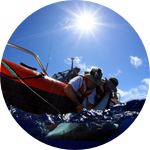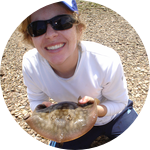About This Project
While mercury is naturally available in the environment, human activities have increased the amount of available mercury, and this has been reflected in the high levels of mercury in shark and ray tissues. However, little is known about how mercury distribution within animals’ tissues changes with age. Using round stingrays, this project will examine how mercury accumulates in different tissues and investigate how their physiology changes with exposure and age.
Ask the Scientists
Join The DiscussionWhat is the context of this research?
Mercury concentrations in the earth’s atmosphere have significantly increased with human activities such as mining and fossil fuel burning. Mercury can be transformed into its more dangerous form (methylmercury) and this form is what becomes concentrated in animals’ tissues. For animals that occupy higher positions in the food web such as elasmobranchs (sharks and rays), mercury can bioaccumulate to high levels due to their long life and carnivorous behavior. Mercury is well known to accumulate in the muscle of sharks. However, the distribution of this contaminant within different tissues and how mercury fluxes from one part of the body to another with age is poorly understood in elasmobranchs, especially for rays and skates as most attention has been directed towards sharks.
What is the significance of this project?
Previous studies on sharks have started to examine the interplay between mercury that is accumulated in muscle and liver. However, the dynamic that exists between these two tissue types is still not well understood. The liver plays a detoxification role in the body while the muscle potentially represents a mercury reservoir. Therefore, mercury accumulation will be dependent on the dynamics of mercury distribution in the body between these two major tissues. Investigating how mercury concentrations change in each of these compartments (i.e. liver and muscle) with age is important for understanding what negative physiological impacts mercury exposure may be having in elasmobranchs. Mercury accumulation and distribution has implications for human health when elasmobranchs are consumed.
What are the goals of the project?
Using analytical chemistry, we plan to measure mercury concentrations in the liver and muscle of round stingrays from juveniles to adults. In addition, we will also quantify the trace metal selenium, which is thought to have a protective effect against mercury exposure. Since the liver is the main detoxifying organ of the body, we will also be using a specific assay to determine the liver’s ability to detoxify mercury, and measure its ability to protect itself from mercury exposure. We will take these measurements for stingrays over a range of sizes to examine how mercury distributions change with age. In addition, we will use several markers (i.e. selenium concentrations and an important liver enzyme) to determine the ability of stingrays to cope with mercury exposure.
Budget
Funds will be used to cover heavy metal analysis (including mercury), which is the most expensive component of the project. Metal analysis can be costly due to the labor, equipment, and reagents needed to analyze samples. Tissue samples have already been obtained so costs for field work etc are not required and all funds raised for this project can go directly to analysis. Analyzing mercury and the other heavy metals found in tissues is most important for understanding how mercury distributes itself throughout animals’ bodies.
A small portion of the funds will be used to cover the cost of the liver glutathione-s-transferase activity assay kit. This is an important part of the project because we will use this to determine the stingrays’ ability to detoxify mercury, and thus, protect their livers from the potential negative impacts of exposure.
Endorsed by
Meet the Team
Affiliates
Kady Lyons
Ever since my parents took me to local aquariums as a toddler, I have been interested in marine biology. However, unlike most children who “want to study ocean animals when they grow up” and then lose this particular interest, I have kept my passion for marine science. I find the crossroads between ecology and physiology and the ability of animals to cope with a changing environment fascinating.
It wasn’t until college that I became aware that pursuing a career in elasmobranch biology was an academic path open to me. I had learned about maternal offloading of contaminants in marine mammals at UCSC so when the opportunity arose with Dr. Chris Lowe (at CSULB) to pursue this line of research in elasmobranchs, an area of study that was not well understood at the time, I took it. Since the field of elasmobranch toxicology is relatively new compared to other areas of study in elasmobranch biology, there
is literally a whole career’s worth of exciting investigation to be conducted. After completing my Master’s, I realized that I had more questions than answers at the end of the degree, which led me to pursue a Ph.D.
In particular, I am interested in elasmobranch physiology as it relates to anthropogenic contaminant accumulation and effects. Another area of interest of mine is maternal transfer and the implications it has on elasmobranch development and fitness. I am extremely excited about my research in elasmobranch toxicology as it is both unique and a novel area of study and look forward to pursuing a career in research.
Project Backers
- 9Backers
- 7%Funded
- $280Total Donations
- $31.11Average Donation


